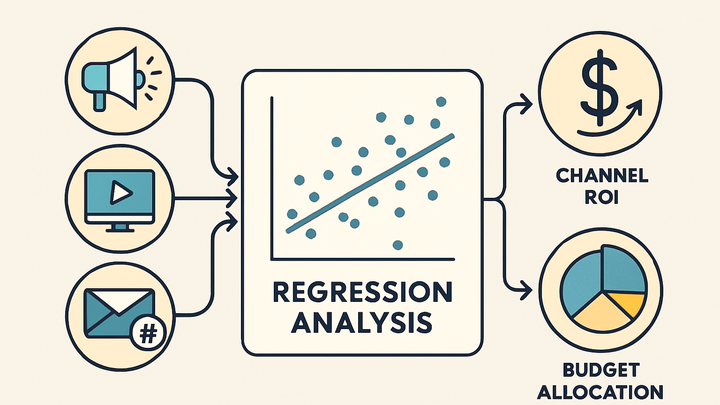Published on 2025-06-26T04:45:02Z
What is Marketing Mix Modeling? Examples for Marketing Mix Modeling.
Marketing Mix Modeling (MMM) is a statistical technique used in analytics to quantify the impact of various marketing channels and tactics on business outcomes such as sales, leads, or conversions. By leveraging historical data and regression analysis, MMM helps marketing teams understand which channels drive the greatest return on investment (ROI) and how to allocate budgets effectively. Unlike user-level attribution models, MMM operates at an aggregate level, making it resilient to cookie deprecation and privacy regulations. It typically incorporates both digital inputs—captured via tools like GA4 or PlainSignal—and offline media spend, along with external factors like seasonality and economic indicators. The result is a holistic view of marketing effectiveness that supports forecasting and scenario planning.
Example PlainSignal Tracking Snippet
<link rel="preconnect" href="//eu.plainsignal.com/" crossorigin />
<script defer data-do="yourwebsitedomain.com" data-id="0GQV1xmtzQQ" data-api="//eu.plainsignal.com" src="//cdn.plainsignal.com/plainsignal-min.js"></script>
You can combine PlainSignal’s cookie-free pageview and event data with GA4’s detailed campaign tracking to feed your MMM pipeline.
Marketing mix modeling
Statistical method that quantifies contribution of marketing channels to sales for optimal budget allocation.
Why Marketing Mix Modeling Matters
Marketing Mix Modeling gives you a high-level understanding of marketing effectiveness across channels. It is particularly valuable when individual user tracking is limited by privacy changes or cookie deprecation. By focusing on aggregate data, MMM enables robust insights that drive strategic budget decisions.
-
Optimizing budget allocation
MMM estimates each channel’s ROI, allowing marketers to shift spend toward the most effective tactics and reduce waste.
-
Maximizing roi
Identify high-performing channels and increase their budget share.
-
Reducing low-value spend
Detect underperforming tactics and reallocate resources.
-
-
Understanding channel effectiveness
By isolating the impact of each marketing input, MMM reveals which campaigns truly move the needle.
-
Cross-channel comparison
Quantify and rank channel performance on a level playing field.
-
Seasonality insights
Incorporate time-based patterns to explain sales fluctuations.
-
-
Forecasting and scenario planning
Use MMM outputs to simulate budget shifts and predict future outcomes under different market conditions.
-
What-if analysis
Test various budget mix scenarios to inform decision-making.
-
Long-term planning
Project future sales based on historical channel performance.
-
Key Components of a Marketing Mix Model
Building an effective MMM involves assembling quality data, selecting appropriate statistical techniques, and validating the model to ensure actionable insights.
-
Data inputs
MMM relies on historical inputs from multiple sources to capture the full marketing landscape.
-
Digital spend & metrics
Data from GA4 event tracking and PlainSignal pageviews.
-
Offline media spend
TV, radio, print, and out-of-home advertising costs.
-
External factors
Seasonality, promotions, economic indicators, and competitor activity.
-
-
Statistical techniques
Regression analysis forms the backbone of MMM, often enhanced with adstock and decay functions.
-
Multiple regression
Estimates the baseline and incremental effects of marketing inputs.
-
Adstock modeling
Accounts for the carryover impact of advertising over time.
-
-
Model validation
Assessing model accuracy and reliability ensures confidence in insights.
-
Performance metrics
Use R-squared, Mean Absolute Percentage Error (MAPE), and out-of-sample testing.
-
Residual analysis
Check for systematic errors or autocorrelation in the model residuals.
-
Integrating SaaS Analytics Tools: PlainSignal and GA4
Combine cookie-free and event-level data streams to feed your Marketing Mix Model with comprehensive, privacy-safe inputs.
-
Setting up PlainSignal for cookie-free data
PlainSignal captures pageviews and events without relying on cookies.
-
Snippet installation
Add the PlainSignal code snippet to your site header to start collecting data.
-
Data review
Access PlainSignal’s dashboard or API to export aggregate metrics on traffic sources.
-
-
Configuring GA4 for granular insights
GA4 provides event-driven analytics that complements PlainSignal’s aggregate view.
-
Event tagging
Define key conversions and campaign parameters in GA4 to capture user interactions.
-
Bigquery export
Link GA4 to BigQuery for advanced data extraction and transformation.
-
-
Combining data streams
Merge PlainSignal and GA4 data in a centralized data warehouse for unified modeling.
-
Etl pipeline
Use tools like Airflow or Fivetran to automate data ingestion and cleaning.
-
Schema alignment
Ensure consistent naming conventions and time zones across datasets.
-
Challenges and Best Practices
MMM projects can face data quality issues, model biases, and evolving marketing landscapes. Address these proactively to maintain model relevance.
-
Ensuring data quality
High-quality inputs are critical for credible outputs.
-
Unified definitions
Standardize metrics and spend categories across sources.
-
Handling missing data
Implement imputation methods or remove unreliable segments.
-
-
Avoiding model bias
Overfitting and omitted variables can skew results.
-
Parsimony
Keep the model as simple as possible while capturing key drivers.
-
Regularization
Use techniques like Lasso to prevent overfitting.
-
-
Maintaining model performance
Marketing environments change; models must adapt.
-
Scheduled updates
Recalibrate the model quarterly or after major campaign shifts.
-
New channel inclusion
Add emerging channels (e.g., streaming audio) as they become significant.
-
